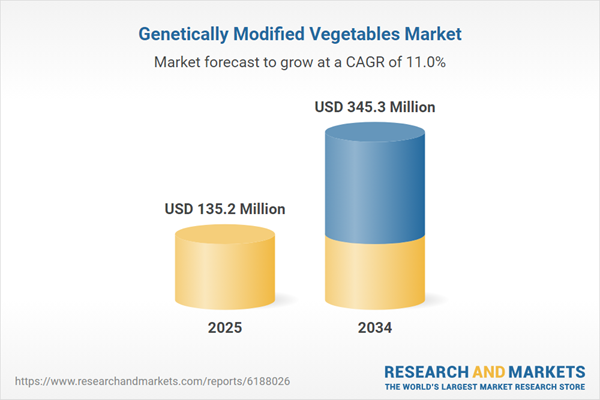The genetically modified (GM) vegetables market is gaining momentum as the demand for higher-yielding, disease-resistant, and nutritionally enhanced crops continues to rise. With a growing global population and increasing concerns over food security, genetically modified vegetables offer a viable solution to enhance agricultural productivity while minimizing resource consumption. Traits such as pest resistance, drought tolerance, and extended shelf life have made GM vegetables an attractive choice for farmers and consumers alike. However, regulatory scrutiny, environmental concerns, and consumer skepticism still pose challenges to widespread adoption. While North America remains a dominant player in the market, emerging economies in Asia-Pacific and Latin America are rapidly adopting GM vegetable cultivation due to rising food demand and supportive policies. As biotechnological advancements continue, the market is expected to witness further innovation, paving the way for sustainable and resilient food systems.
The genetically modified vegetables market experienced significant progress, driven by regulatory approvals and technological breakthroughs. Several countries, including China and India, eased restrictions on GM crop cultivation, allowing farmers access to high-yield, pest-resistant vegetable varieties. Advances in CRISPR gene-editing technology enabled the development of GM vegetables with enhanced nutrient profiles and improved resistance to environmental stressors. Consumer acceptance also improved, particularly in regions where food security concerns were pressing. The year saw increased investments from biotechnology firms and agricultural companies in research and development, leading to the commercialization of new GM vegetable varieties. Additionally, the expansion of controlled environment agriculture (CEA), such as vertical farming and hydroponics, provided an ideal setting for GM vegetables to thrive with reduced dependency on chemical pesticides. Despite progress, challenges persisted, particularly in Europe, where regulatory frameworks remained stringent, and public opposition slowed adoption.
The genetically modified vegetables market is expected to witness further expansion, driven by evolving consumer preferences and advancements in gene-editing techniques. The integration of artificial intelligence and big data in agricultural biotechnology will accelerate the development of next-generation GM vegetables with tailored nutritional benefits and improved climate resilience. Regulatory landscapes are also expected to become more accommodating in several countries, particularly in Africa and Southeast Asia, where food security concerns are paramount. Additionally, the growing acceptance of precision agriculture will enhance the efficiency of GM vegetable farming, leading to better yields and reduced environmental impact. The rising demand for plant-based and functional foods is likely to create opportunities for genetically modified vegetables with enhanced health benefits, such as increased antioxidant content or improved digestibility. However, ethical debates and consumer skepticism will remain key challenges, requiring transparent labeling and public awareness campaigns to drive market acceptance.
Key Insights: Genetically Modified Vegetables Market
- Advancements in Gene-Editing Technologies: Breakthroughs in CRISPR and RNA interference are enabling more precise modifications in vegetable crops, enhancing their nutritional content and disease resistance.
- Growing Demand for Climate-Resilient Crops: Climate change is increasing the need for GM vegetables that can withstand extreme weather conditions, ensuring food security in vulnerable regions.
- Expansion of Controlled Environment Agriculture (CEA): Vertical farming and hydroponics are providing optimal conditions for GM vegetables, minimizing pesticide use and maximizing yields.
- Increasing Consumer Acceptance in Emerging Markets: Rising food security concerns and government support in countries like China, India, and Brazil are fostering higher acceptance of GM vegetables.
- Integration of AI in Agricultural Biotechnology: AI-driven research is accelerating the discovery and optimization of genetically modified vegetable traits, making crop development more efficient.
- Rising Global Food Demand: The increasing population and shrinking arable land are driving the need for high-yield, genetically modified vegetable crops to ensure food security.
- Government Support and Policy Relaxations: Several countries are easing restrictions and promoting GM crops to enhance agricultural productivity and reduce dependency on imports.
- Improved Nutritional Profiles: Advances in genetic engineering are allowing for the development of GM vegetables with enhanced vitamins, antioxidants, and other health benefits.
- Reduction in Pesticide and Herbicide Use: GM vegetables with in-built pest and disease resistance are reducing the need for chemical applications, making agriculture more sustainable.
- Consumer Skepticism and Ethical Concerns: Public concerns over the long-term health effects and environmental impact of GM vegetables continue to limit their widespread acceptance, necessitating transparent communication and regulatory oversight.
Genetically Modified Vegetables Market Segmentation
By Type Of Modification
- Transgenic
- Cis-Genic
- Sub-Genic
- Multiple Trait Integration
By Crop
- Soybean
- Cotton
- Maize
- Oilseed Rape
- Canola
- Alfalfa
- Other Crops
By Technique
- Gene Guns
- Electroporation
- Microinjection
- Agrobacterium
- Other Techniques
By Trait
- Herbicide Tolerance (HT)
- Insect Resistance (IR)
- Stacked Traits
- Other Traits
By Application
- Scientific Research
- Agriculture Crops
Key Companies Analysed
- BASF SE
- Bayer AG
- The Dow Chemical Company
- Syngenta AG
- Dupont de Nemours Inc.
- Groupe Limagrain Holding SA
- JR Simplot Company
- JKAgri Genetics Ltd.
- Mahyco Private Limited
- Calyxt Inc.
- Stine Seed Farm Inc.
- Nuseed Pty Ltd.
- KWS SAAT SE & Co. KGaA
- Sakata Seed Corporation
- Okanagan Specialty Fruits Inc.
- Pairwise Plants LLC
- EuropaBio
- Biotechnology Industry Organization
- Corteva Inc.
- Sakata Seed America Inc.
- Jivo Wellness Pvt Ltd.
- Ambar Protein Industries Limited
- The Monsanto Company
- Limagrain Holding SA
- Precigen Inc.
- Arcadia Biosciences Inc.
- Aerofarms Inc.
- Benson Hill Biosystems Inc..
Genetically Modified Vegetables Market Analytics
The report employs rigorous tools, including Porter’s Five Forces, value chain mapping, and scenario-based modeling, to assess supply-demand dynamics. Cross-sector influences from parent, derived, and substitute markets are evaluated to identify risks and opportunities. Trade and pricing analytics provide an up-to-date view of international flows, including leading exporters, importers, and regional price trends.Macroeconomic indicators, policy frameworks such as carbon pricing and energy security strategies, and evolving consumer behavior are considered in forecasting scenarios. Recent deal flows, partnerships, and technology innovations are incorporated to assess their impact on future market performance.
Genetically Modified Vegetables Market Competitive Intelligence
The competitive landscape is mapped through proprietary frameworks, profiling leading companies with details on business models, product portfolios, financial performance, and strategic initiatives. Key developments such as mergers & acquisitions, technology collaborations, investment inflows, and regional expansions are analyzed for their competitive impact. The report also identifies emerging players and innovative startups contributing to market disruption.Regional insights highlight the most promising investment destinations, regulatory landscapes, and evolving partnerships across energy and industrial corridors.
Countries Covered
- North America - Genetically Modified Vegetables market data and outlook to 2034
- United States
- Canada
- Mexico
- Europe - Genetically Modified Vegetables market data and outlook to 2034
- Germany
- United Kingdom
- France
- Italy
- Spain
- BeNeLux
- Russia
- Sweden
- Asia-Pacific - Genetically Modified Vegetables market data and outlook to 2034
- China
- Japan
- India
- South Korea
- Australia
- Indonesia
- Malaysia
- Vietnam
- Middle East and Africa - Genetically Modified Vegetables market data and outlook to 2034
- Saudi Arabia
- South Africa
- Iran
- UAE
- Egypt
- South and Central America - Genetically Modified Vegetables market data and outlook to 2034
- Brazil
- Argentina
- Chile
- Peru
Research Methodology
This study combines primary inputs from industry experts across the Genetically Modified Vegetables value chain with secondary data from associations, government publications, trade databases, and company disclosures. Proprietary modeling techniques, including data triangulation, statistical correlation, and scenario planning, are applied to deliver reliable market sizing and forecasting.Key Questions Addressed
- What is the current and forecast market size of the Genetically Modified Vegetables industry at global, regional, and country levels?
- Which types, applications, and technologies present the highest growth potential?
- How are supply chains adapting to geopolitical and economic shocks?
- What role do policy frameworks, trade flows, and sustainability targets play in shaping demand?
- Who are the leading players, and how are their strategies evolving in the face of global uncertainty?
- Which regional “hotspots” and customer segments will outpace the market, and what go-to-market and partnership models best support entry and expansion?
- Where are the most investable opportunities - across technology roadmaps, sustainability-linked innovation, and M&A - and what is the best segment to invest over the next 3-5 years?
Your Key Takeaways from the Genetically Modified Vegetables Market Report
- Global Genetically Modified Vegetables market size and growth projections (CAGR), 2024-2034
- Impact of Russia-Ukraine, Israel-Palestine, and Hamas conflicts on Genetically Modified Vegetables trade, costs, and supply chains
- Genetically Modified Vegetables market size, share, and outlook across 5 regions and 27 countries, 2023-2034
- Genetically Modified Vegetables market size, CAGR, and market share of key products, applications, and end-user verticals, 2023-2034
- Short- and long-term Genetically Modified Vegetables market trends, drivers, restraints, and opportunities
- Porter’s Five Forces analysis, technological developments, and Genetically Modified Vegetables supply chain analysis
- Genetically Modified Vegetables trade analysis, Genetically Modified Vegetables market price analysis, and Genetically Modified Vegetables supply/demand dynamics
- Profiles of 5 leading companies - overview, key strategies, financials, and products
- Latest Genetically Modified Vegetables market news and developments
Additional Support
With the purchase of this report, you will receive:- An updated PDF report and an MS Excel data workbook containing all market tables and figures for easy analysis.
- 7-day post-sale analyst support for clarifications and in-scope supplementary data, ensuring the deliverable aligns precisely with your requirements.
- Complimentary report update to incorporate the latest available data and the impact of recent market developments.
This product will be delivered within 1-3 business days.
Table of Contents
Companies Mentioned
- BASF SE
- Bayer AG
- The Dow Chemical Company
- Syngenta AG
- Dupont de Nemours Inc.
- Groupe Limagrain Holding SA
- JR Simplot Company
- JKAgri Genetics Ltd.
- Mahyco Private Limited
- Calyxt Inc.
- Stine Seed Farm Inc.
- Nuseed Pty Ltd.
- KWS SAAT SE & Co. KGaA
- Sakata Seed Corporation
- Okanagan Specialty Fruits Inc.
- Pairwise Plants LLC
- EuropaBio
- Biotechnology Industry Organization
- Corteva Inc.
- Sakata Seed America Inc.
- Jivo Wellness Pvt Ltd.
- Ambar Protein Industries Limited
- The Monsanto Company
- Limagrain Holding SA
- Precigen Inc.
- Arcadia Biosciences Inc.
- Aerofarms Inc.
- Benson Hill Biosystems Inc. .
Table Information
| Report Attribute | Details |
|---|---|
| No. of Pages | 160 |
| Published | October 2025 |
| Forecast Period | 2025 - 2034 |
| Estimated Market Value ( USD | $ 135.2 Million |
| Forecasted Market Value ( USD | $ 345.3 Million |
| Compound Annual Growth Rate | 10.9% |
| Regions Covered | Global |
| No. of Companies Mentioned | 28 |









